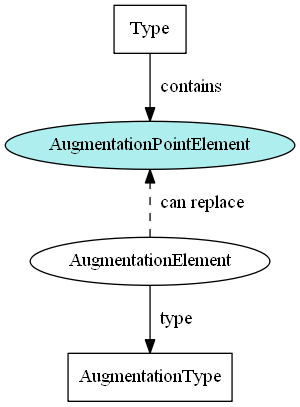- Home
- Reference
- Model Concepts
- Augmentations
- Augmentation Points
- Augmentation Points in XML
Augmentation Points in XML

Instances
Augmentation point elements do not appear in XML instances because they are abstract. They may only be omitted or replaced by their concrete substitutions. See Augmentation Elements in XML for an example of how augmentation elements replace an augmentation point in an instance.
Schema example
This snippet, from a subset of Core, shows how augmentation point element nc:PersonAugmentationPoint is defined and referenced by nc:PersonType:
<xs:complexType name="PersonType">
<xs:annotation>
<xs:documentation>A data type for a human being.</xs:documentation>
</xs:annotation>
<xs:complexContent>
<xs:extension base="structures:ObjectType">
<xs:sequence>
<xs:element ref="nc:PersonBirthDate" minOccurs="0" maxOccurs="unbounded"/>
<xs:element ref="nc:PersonName" minOccurs="0" maxOccurs="unbounded"/>
<xs:element ref="nc:PersonAugmentationPoint" minOccurs="0" maxOccurs="unbounded"/>
</xs:sequence>
</xs:extension>
</xs:complexContent>
</xs:complexType>
<xs:element name="PersonAugmentationPoint" abstract="true">
<xs:annotation>
<xs:documentation>An augmentation point for PersonType.</xs:documentation>
</xs:annotation>
</xs:element>
nc:PersonTypeincludes a reference to its augmentation point (nc:PersonAugmentationPoint) as its last sub-element.- The augmentation point element is abstract and has no type.
Schema template
This template shows the declaration of a complex type that references its augmentation point, and the declaration of the augmentation point element itself.
<!-- NIEM type with sub-elements, like nc:PersonType -->
<xs:complexType name="NAMEType">
<xs:annotation>
<xs:documentation>A data type for a(n) {$Definition}</xs:documentation>
</xs:annotation>
<xs:complexContent>
<xs:extension base="PARENT_TYPE">
<xs:sequence>
<xs:element ref="ELEMENT1" minOccurs="0" maxOccurs="unbounded"/>
<xs:element ref="ELEMENT2" minOccurs="0" maxOccurs="unbounded"/>
<xs:element ref="NAMEAugmentationPoint" minOccurs="0" maxOccurs="unbounded"/>
</xs:sequence>
</xs:extension>
</xs:complexContent>
</xs:complexType>
<!-- Augmentation Point Element, like nc:PersonAugmentationPoint -->
<xs:element name="NAMEAugmentationPoint" abstract="true">
<xs:annotation>
<xs:documentation>An augmentation point for NAMEType</xs:documentation>
</xs:annotation>
</xs:element>
Partial template
Augmentation points do not actually require that many lines to create. The majority of the template above shows how to create a type. Only one line in the type declaration actually involves the augmentation point.
Without the rest of the type declaration, the template would look like:
<!-- Complex type declaration -->
<xs:element ref="NAMEAugmentationPoint" minOccurs="0" maxOccurs="unbounded"/>
<!-- End of complex type declaration -->
<!-- Augmentation Point Element, like nc:PersonAugmentationPoint -->
<xs:element name="NAMEAugmentationPoint" abstract="true">
<xs:annotation>
<xs:documentation>An augmentation point for NAMEType</xs:documentation>
</xs:annotation>
</xs:element>
This is much simpler: one new augmentation point element, and one reference to it from its type.